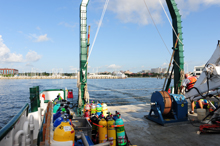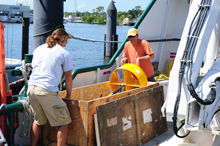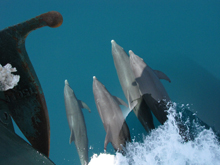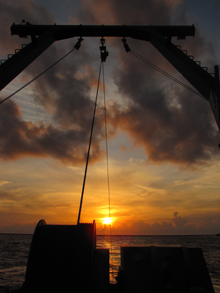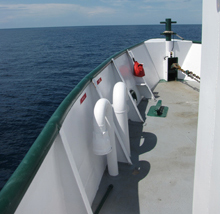
The port bow of the University of South Florida research vessel (R/V) Weatherbird II. Click image for larger view.
A view from the stern of the R/V Weatherbird II as it leaves the port in St. Petersburg, Florida. Click image for larger view.
Benjamin Wells and Cliff Brown attempt to lift the towfish. Click image for larger view.
Dolphins off the bow. Click image for larger view.
The U-frame (at the top) creates a visual border as the sun sets beyond the Gulf of Mexico. Click image for larger view.
The First 24 Hours at Sea
July 23, 2009
Justin Halteman
Harvard University Extension School
![]() Watch a video slideshow of images that include some related to today's log.
Watch a video slideshow of images that include some related to today's log.
To start the day off, the archaeology crew ate breakfast at the hotel around 7 a.m., and headed off to the boat by 8 a.m. Captain Matt gave a safety speech and covered some ship rules. We cast off from the dock around 9 a.m. So far we have had perfect weather. Very calm seas . . . flat as glass. It is really quite amazing.
Having not experienced the ocean this far south, I had never seen flying fish before this exploration. Right now the flying fish are skipping all over the place; and they are quite fun to watch. Co-principal investigator Dr. Andrew Hemmings phrased it best: “A school of flying fish launching across glassy water is like fireworks — but better: they just explode out and leave little wake ripples in every direction.”
We lost sight of land around 1 p.m., and the crystal-smooth flatness of the calm water spread to all horizons. It took us a full 12 hours to approach the Florida Middle Grounds, where we intend to run side scan sonar and sub-bottom profiling transects all night. Tomorrow morning we will send scuba divers down to the possible Pleistocene lakebed shoreline, which the sonar mapping will highlight for us.
During our 12-hour journey, I spent a couple of hours after lunch learning about the software we'll be using for this trip. This is my first time doing archaeology underwater, and it was exciting to get started. We set up transect lines and programmed them into the computers so that we will be all ready to start mapping immediately upon arrival at the site.
I also used the motoring time to familiarize myself with the research vessel Weatherbird II. I found my way out to the bow and saw four dolphins headed our way. I was told they feed on the flying fish, and that when the dolphins see a boat they often come play with the wake. My hopes were fulfilled when they all came up to the bow, mere feet away from me, and played happily for a good ten minutes. The day of transit was capped off with the beauty of an ocean sunset, throwing its color show across the wide-open waters.
We finally reached our mapping grounds just after 10:30 p.m., and got the towfish (the unit which houses the remote-sensing components) into the water. Sleep is often at a premium on this busy boat, and I managed to get some rest before waking at 3:45 a.m. Coffee was being brewed for my 4- to 7-a.m. shift, monitoring the sonar I had learned about earlier. Working with the experienced crew members made the steep learning curve a tolerable one. We plotted many targets that had significant seafloor features. Those targets were to be used to pick dive points in the coming days.
That early morning shift rounded out my first 24 hours on an offshore archaeology expedition. With any luck, some of those points may lead us to the evidence of settlements left here by the very first people in North America — more than 11,000 years ago.
Sign up for the Ocean Explorer E-mail Update List.















